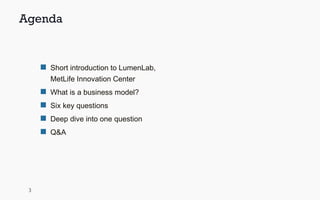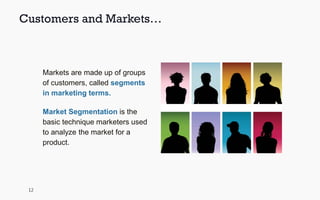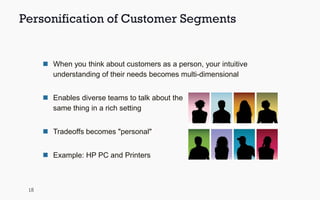Dr Lee Ng - 6 key questions when building products
- 1. 1 a MetLife Innovation Centre 6 key questions when building products February 2016 Dr. Lee Ng
- 2. 2 a MetLife Innovation Centre Professionally, I look for small ideas that can have big impact for business CEO, CFO, CDO, author 21 years in Silicon Valley Advisor at DraperNexus and Wavemaker Labs Engineer, Ph.D. Business background
- 3. 3 Agenda Short introduction to LumenLab, MetLife Innovation Center What is a business model? Six key questions Deep dive into one question Q&A
- 4. 4 Lighting a path for innovation at MetLife LumenLab was established in 2014 in Singapore as a core pillar of growth and differentiation for MetLife in Asia New businesses separate from MetLife’s core insurance focus Building the culture of innovation within MetLife in 10+ countries across the region Creating new businesses targeting the needs of Asian consumers across: HEALTH WEALTH RETIREMENT 1 2 3 OUR MISSION BUILDING CULTURE & CAPABILITY BUILDING BUSINESSES
- 5. 5 Create an insight-driven growth engine... … that empathizes deeply with our customers’ problems… … to build scalable businesses that add value across the enterprise. MISSION CORE CAPABILITIES VISION MetLife is recognized as the industry’s innovation leader 1 2 3 Our vision and mission is to create a growth engine that builds new businesses
- 6. 6 Incubated ideas that grow into new, revenue-generating businesses for MetLife Build Businesses 80% Build Capability 20% PRETOTYPING CONSUMER INSIGHTS SCALE PARTNERSHIPS WORKSHOPS BOOTCAMPS FINANCIAL MODELING MARKET RESEARCH IDEA SHAPING Our focus is on building businesses & capabilities Developing innovation culture & capability in the region via learning & doing
- 7. 7 a MetLife Innovation Centrea MetLife Innovation Centre How to think about creating a new business?
- 8. 8 What is a Business Model? Source: Onset Ventures BusinessCompanyProductTechnology Opportunity Value Proposition Distribution Strategy Financial Model Market Problem Buyer Budget
- 9. 9 What is in a business plan? Who is the customer?1 What is the product?2 Who else will serve them?3 How will you tell them?4 How can they buy it?5 Where is the money?6
- 10. 10 Who is the Customer? The Customer is the person who.. ... signs the CHECK ... forks over the CASH ... pays the MONEY Marketing 101 – The Whole Course And the user may not be buyer…
- 11. 11 Who is not the customer? Everyone "Everyone will want one" The Industry "Anyone making bricks will need it" The Company "GE needs this to survive" A Group "Horse riders have been waiting for this" Their Customer "Just get them to say <Yes>" Build and They Will Come "They don’t know they need it yet"
- 12. 12 Customers and Markets… Markets are made up of groups of customers, called segments in marketing terms. Market Segmentation is the basic technique marketers used to analyze the market for a product.
- 13. 13 Market Segmentation Segmentation is the process by which groups of prospects with similar purchase preferences put themselves into definable clusters or "segments." A fact based analysis of users' needs and the key factors that influence purchase decisions provides the foundation for this process. Effective segmentation allows the business to prioritize and devote resources to those segments where XXXX can deliver superior value to the customer. Market segmentation enables decisions to be made on the level of product or service specialization. It also enables one to describe the benefits appropriately to the end user. « He can compress the most words into the smallest idea of any man I know. » Abraham Lincoln (1809-1865) XXXX Corporate Marketing Guide
- 14. 14 Market Segmentation « Consumers are statistics. Customers are people. » Stanley Marcus WHY? WHAT? So you can identify what capabilities we need to develop (or acquire) to serve the segment profitably Segments: Have a set of common customer requirements Have measurable characteristics (# of customers, annual purchases, growth rate) Have identifiable competitors Have a common sales or distribution channel Have the same present or future key success factors
- 15. 15 Examples of Segmentation: Pen Can Mont Blanc Pen re-segment the market in a new way to serve customers better or expand its market? ? From the book "Profitable Growth" How can we describe who buys Mont Blanc Pen? Simple Segmentation Segmentation by Needs and Channel Everyone that uses a pen Distribution Channel Why Buy? Dept Stores Specialty Stores Personal Gifts Ego Satisfaction
- 16. 16 Re-segmentation Dept Stores Specialty Corporate Personal gift x% y% NA Ego p% q% NA Corporate Gifts NA b% c% Market Segmentation determines product features and channel strategies! Segmentation provides new insights into user needs, which in terms will allow us to serve them better. New segmentation will reveal attributes that may be attractive to new segments.
- 17. 17 Market Segment Myths WE segment markets. Buyers and users form segments based on their needs and the problems they are trying to solve There is ONE ideal segmentation variable. The segments that really matter are the benefits and price. Many others can stimulate imaginative understanding (application, industry, company size, income level, geography, price, age, religion, education, lifestyle, values,…) Segments are PRODUCTS. Segments are based on user needs not products, not technologies. Other products may deliver the same benefits. Segments are FOREVER. Segments change along with user needs and other products. 1 2 3 4 M Y T H S
- 18. 18 Personification of Customer Segments When you think about customers as a person, your intuitive understanding of their needs becomes multi-dimensional Enables diverse teams to talk about the same thing in a rich setting Tradeoffs becomes "personal" Example: HP PC and Printers
- 19. 19 Bottomline • To build a business, you need to address all 6 key questions • Customer and Product are the Siamese twins of a Business • Make sure you take a holistic view toward them, and iterate as necessary.
- 20. 20 a MetLife Innovation Centre Want to know more? Lee Ng lee@lumenlab.sg




















